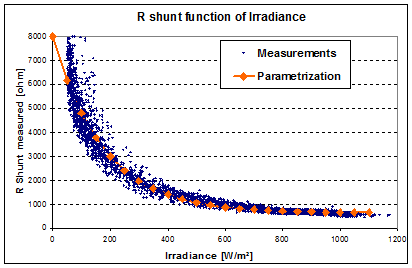PV modules - Model parameters
This page gives access to several tools for the determination of all secondary parameters of the PV module model.
Rshunt - Rserie
These are the 2 main parameters of the one-diode model. PVsyst always proposes default values which may be recovered by clicking the "Default" checkboxes.
| Rshunt | is the inverse of the slope -dV/dI of the I/V curve around the Isc value. The default value proposed by PVsyst corresponds to a given fraction of the slope (Isc-Impp) / Vmpp. With modern crystalline modules the Rshunt is high (i.e. the curve is very flat) and the associated loss is therefore low, so that an accurate determination is not crucial. The flash-test measurements accuracy is usually not sufficient for a reliable determination, as it suffers of capacitive errors due to the high sweep speed. Therefore it is advised to rely on the PVsyst default value. With amorphous and other thin film modules, the Rshunt is low and easily measurable. Using measurements on the I/V curve of real modules reduces the uncertainties during the determination of the other model parameters (Rseries and d2Mutau). |
| Rseries | is the internal series resistance of the one-diode model. It is one of the parameters of the model at STC, not directly measurable using the I/V curve. Its determination is crucial, and has consequences on the low-light performances. See Rseries determination. |
| RseriesApp | The "apparent" series resistance is the inverse of the slope -dV/dI around Voc. This measurable value is sometimes called Rseries in the datasheets, but it should not be confused with the Rseries of the one-diode model as described just above. This value is greater as it includes the contribution of the slope of the diode exponential at the Voc point. |
| Diode saturation current | is one of the parameters of the one-diode model, which highly varies with the temperature. |
| Diode quality factor | called Gamma in PVsyst, is one of the parameters of the one-diode model. Its value should "physically" be between 1 and 2 per junction, but this is not always the case. In the PVsyst implementation of the one-diode model, we have introduced the possibility of a linear variation of the gamma parameter according to the temperature. This allows to match exactly the muPmpp value as specified by the manufacturer. With crystalline modules the model determines the muPmpp value with an excellent accuracy, and this muGamma value is usually very close to 0. |
| Voltage temp. coefficient muVoc | is a result of the model. Usually it doesn't fit exactly the specified muVco value, but It cannot be modified in the model. The program stores the specified muVco when defined, value which may eventually be used during the sizing process (determination of Voc at the lowest temperature) if desired. |
Rshunt expon
According to our long-term measurements of modules at sun, it appears that for all modules of all technologies the Rshunt measured value is strongly dependent on the Irradiance, and may be approximated by an exponential expression.
(here an amorphous module, EPV40).
We observed that in most of our measurements (crystalline, amorphous), an exponential parameter of 5.5 is suitable. For CdTe the suited value was about 3.0.
| Rshunt at Ginc=0 (Rsh(0) | is therefore the main characteristic parameter of the distribution. We can adjust it on the data, by eye. We observed that for the crystalline modules, a ratio Rsh(0) / Rsh = 4 is suitable. For amorphous this ratio is very similar for all modules, i.e. about 12. These are the default values proposed by PVsyst. |
| Expon parameter RshExp | is the exponential parameter, that you should let at its default value unless you can extract it from a set of well-established measurements for the specific modules you use. |
| Fitting tool | allows to input some measured values when available. The program will then adjust the parameters at best. |
Temperature coefficient
The temperature coefficient on power muPmpp is a result of the model. For crystalline modules its value is usually very close to the specified value (-0.42 to -0.45%/°C).
Checking Apply the correction will adjust the muGamma (a linear variation of the gamma parameter as function of the temperature) in order to match the specified temperature coefficient muPmpp.
NB:
- this has also an effect on the muVco behaviour.
- Please note that the Pmpp behaviour is not necessarily linear with the temperature: the muPmpp may vary with the temperature. |
Recombination loss
This page is only available with amorphous (and micro-crystalline or CdTe) modules, for which the PVsyst model includes a special recombination correction.
According to our measurements, this parameter should be chosen at a high value, about 80% of its maximum possible value, for better representing the measurements under any irradiance and temperature conditions.
However the value of this parameter - and its maximum possible value - is strongly dependent on both Rseries and Rshunt values. These 3 variables and their variation domain are closely related, in highly non-linear equations. And the determination of the default values by PVsyst is sometimes not unique: passing from the "Reconbination Loss" default to "Rserie" default and reciprocally may modify the values before stabilization.
The default values determination is based on the predefined value of d2MuTau and the temperature behavior muPmpp. It also involves the muGamma parameter.
NB: These parameters for thin film modules are very specific to the PVsyst model. You are not advised to play with them without understanding the consequences on the model behavior. In case of doubt you should rely to the PVsyst default values, or contact the author of the program (model).
Spectral correction
PVsyst can only apply a spectral correction to amorphous and micro-crystalline modules. This page allows to decide if you want to apply it or not.
